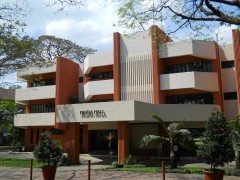Fr. Jett Villarin, SJ visits the Ateneo Innovation Center: the accelerometer tsunami sensor, spoonless stirrer, and other toys
June 29, 2011 1 Comment
by Quirino Sugon Jr.

Fr. Jett Villarin, SJ listens to a student explaining the accelerometer seismic sensor (photo courtesy of Paul Cabacungan of the Ateneo Innovation Center)
Last June 8, 2011, I called up Paul Cabacungan of the Ateneo Innovation Center (AIC) regarding his invitation for me the previous day to visit the AIC and see their new accelerometer sensors for earthquakes. Dr. Greg Tangonan, the Director of the AIC, keeps me in the loop regarding the possibilities of having accelerometers installed in buildings as seismic sensors, as done in Taiwan and in other places. My interest in these sensors is related to the concept of vibrational spectroscopy: molecules vibrate more wildly at certain electromagnetic frequencies than at others, which is the reason why microwave ovens can heat a cup of water in the same way as sopranos can break glass. Buildings have also natural frequencies of vibration and if these matches with that of an earthquake, even a low intensity earthquake can destroy the whole structure. If we can put accelerometers in each corner of each building floor, we can use symmetry analysis (group theory for geeks) in crystallography to deduce not only the normal modes of oscillations of the buildings–those twisting and waving vibrations–but also the intensity and source of the earthquake.
“Hi, Paul. Sorry, I was not able to come yesterday. Can I visit the AIC now.”
“That’s just right, Sir Pope. Fr. Jett Villarin is now here.”
“Okay, I’ll be there.”
Off I went from my office in the Ionosphere Research Building in Manila Observatory. According to Euclid, the shortest path between two points is a straight line. But since walking speed depends on whether the ground is soil, cement, or grass, I used Fermat’s principle to find the path that leads to AIC in the shortest time. I can’t reproduce my Feynman’s path integral solution here, but in less than 5 minutes of running like hell, I arrived in Faura.
I climbed the stairs to the second floor. Through the glass window on the AIC door, I saw that the room was full. Dr. Tangonan was there, together with Dr. Fabian Dayrit. And there is Fr. Jett Villarin, SJ, sitting down, listening to a graduate student as she explains the sandwich of wafer chips on the table. Upon Paul’s signal, I went in. (see pictures from the Ateneo Innvation Facebook page here.)
“Father,” the student said. “These are accelerometer sensor chips. We placed them on top of each other and placed these in bouys out in the sea. So when tsunami comes, the accelerometers would get a high acceleration readings. The readings are sent to our computer via SMS, just like what we do when we text through our cellular phones.”
“I imagine that texting requires electrical power,” Fr. Jett said. “Where do you get your power?”
“It is from solar panels, Father.”
“Actually, we don’t text all the data,” said Dr. Tangonan. “We have a software in the instrument that preprocesses the data. If the software finds anomalous spikes in the acceleration, that’s the only time the instrument sends the SMS. In this way, we save power.”
SMS is Short Message Service. In the days of the telegraph, the SMS is SOS. That is three short dots followed by three dashes and then by three dots: … _ _ _ …, which is the Morse code for the letters “S”, “O”, and “S”. Some people have given an interpretation to SOS as “Save Our Ship” or “Save Our Souls”. I guess, today’s piety has because more individualistic: SMS may be interpreted as “Save My Ship” or “Save my Soul”. If all else fails, we can always resort to the traditional way: SMB or Short Message in a Bottle.
The next student presented another device: a glass filled with water sitting on a small metallic casing as big as a palm. He pushed the button. And the water spun like a tornado. Inside this miniature tornado is a low pressure area filled with air surrounded by water, rotating faster as the distance from the tornado decreases. That’s Bernoulli’s principle in action.
“Unbelievable!” exclaimed Fr. Jett. “How did you do it.”
“The base is just a discarded computer hard drive. It can even warm the water.”
“Well, that’s obvious,” said Fr. Jett. “Your laptop gets warm when you use it.”
“You can also make the water cooler.”
The student pushed another button. Fr. Jett touched it. He agreed.
Now, my physics sense can’t understand how it cooled. Maybe there is some sort of Carnot engine there like a refrigerator that removes heat and pumps it out of the system.
“We are pushing this as an innovation for car owners,” said Dr. Tangonan. If you have coffee, you can make it. If a soft drink, you can make it cold. And you have a stirrer without a spoon.”
“This is cool. I can even bring this in my meteorology class to illustrate hurricanes. But how does it stir without a spoon?” asked Fr. Jett.
“There is a magnet inside the glass.”
And the student put his hand on the glass of water and took a white shimmering piece that looks like Mentos, but twice as big.
“This magnet has a special coating, so it won’t mix with your coffee or softdrink or water.”
“That’s cheating!” Fr. Jett laughed.
We can’t see the magnet because there is a piece of thick paper wound at the base to prevent the water from spilling to the hard drive. I was also tricked myself. I thought that the instrument has a way of manipulating the charges in the water and spin them around like Magneto in X-men. But in this case, little magneto is the one spinning as the hard drive turns, increasing the speed of the water in the glass, until centrifugal forces force the water to the sides of the glass, creating a low pressure area in the middle of the fluid. Even now that I know how it works, I am still amazed.
There are still other things that the Ateneo Innovation Center showed Fr. Jett, like the bamboo bike and the solar-powered LED lamps. But the accelerometer and the spoonless stirrer has made a deep impression on me.
After the talk, I went down the stairs with Fr. Jett.
“Where are you going now, Pope?”
“I am going back to my office, Father.”
We bade goodbye and parted ways.

